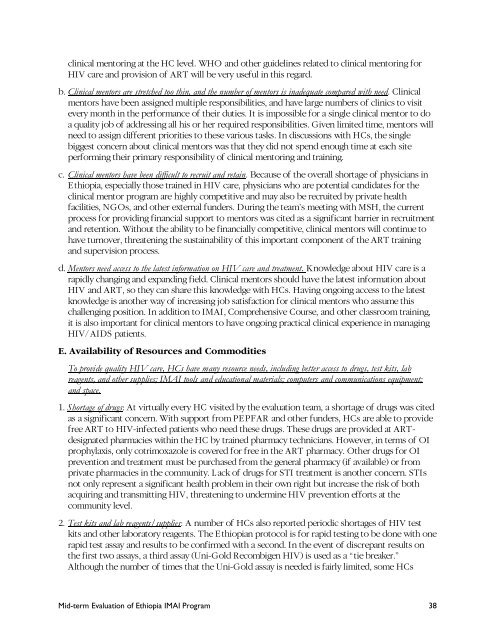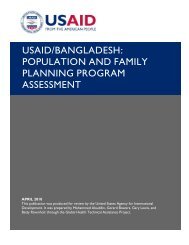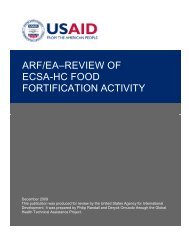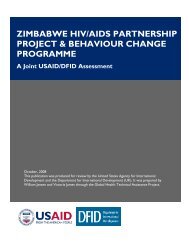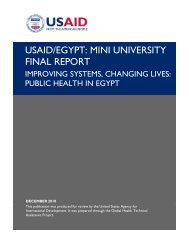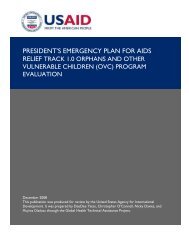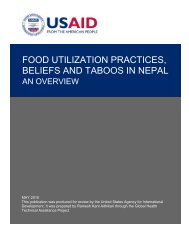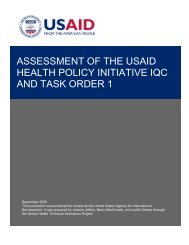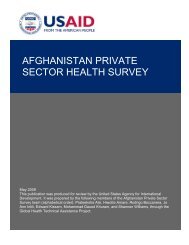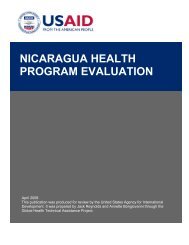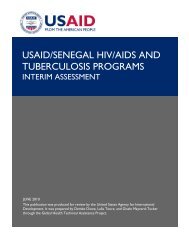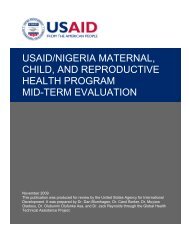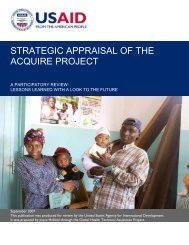usaid/ethiopia pepfar mid-term evaluation of the ... - GH Tech
usaid/ethiopia pepfar mid-term evaluation of the ... - GH Tech
usaid/ethiopia pepfar mid-term evaluation of the ... - GH Tech
- No tags were found...
Create successful ePaper yourself
Turn your PDF publications into a flip-book with our unique Google optimized e-Paper software.
clinical mentoring at <strong>the</strong> HC level. WHO and o<strong>the</strong>r guidelines related to clinical mentoring forHIV care and provision <strong>of</strong> ART will be very useful in this regard.b. Clinical mentors are stretched too thin, and <strong>the</strong> number <strong>of</strong> mentors is inadequate compared with need. Clinicalmentors have been assigned multiple responsibilities, and have large numbers <strong>of</strong> clinics to visitevery month in <strong>the</strong> performance <strong>of</strong> <strong>the</strong>ir duties. It is impossible for a single clinical mentor to doa quality job <strong>of</strong> addressing all his or her required responsibilities. Given limited time, mentors willneed to assign different priorities to <strong>the</strong>se various tasks. In discussions with HCs, <strong>the</strong> singlebiggest concern about clinical mentors was that <strong>the</strong>y did not spend enough time at each siteperforming <strong>the</strong>ir primary responsibility <strong>of</strong> clinical mentoring and training.c. Clinical mentors have been difficult to recruit and retain. Because <strong>of</strong> <strong>the</strong> overall shortage <strong>of</strong> physicians inE thiopia, especially those trained in HIV care, physicians who are potential candidates for <strong>the</strong>clinical mentor program are highly competitive and may also be recruited by private healthfacilities, NGOs, and o<strong>the</strong>r external funders. During <strong>the</strong> team’s meeting with MSH, <strong>the</strong> currentprocess for providing financial support to mentors was cited as a significant barrier in recruitmentand retention. Without <strong>the</strong> ability to be financially competitive, clinical mentors will continue tohave turnover, threatening <strong>the</strong> sustainability <strong>of</strong> this important component <strong>of</strong> <strong>the</strong> ART trainingand supervision process.d. Mentors need access to <strong>the</strong> latest information on HIV care and treatment. Knowledge about HIV care is arapidly changing and expanding field. Clinical mentors should have <strong>the</strong> latest information aboutHIV and ART, so <strong>the</strong>y can share this knowledge with HCs. Having ongoing access to <strong>the</strong> latestknowledge is ano<strong>the</strong>r way <strong>of</strong> increasing job satisfaction for clinical mentors who assume thischallenging position. In addition to IMAI, Comprehensive Course, and o<strong>the</strong>r classroom training,it is also important for clinical mentors to have ongoing practical clinical experience in managingHIV/AIDS patients.E. Availability <strong>of</strong> Resources and CommoditiesTo provide quality HIV care, HCs have many resource needs, including better access to drugs, test kits, labreagents, and o<strong>the</strong>r supplies; IMAI tools and educational materials; computers and communications equipment;and space.1. Shortage <strong>of</strong> drugs: At virtually every HC visited by <strong>the</strong> <strong>evaluation</strong> team, a shortage <strong>of</strong> drugs was citedas a significant concern. With support from PE PFAR and o<strong>the</strong>r funders, HCs are able to providefree ART to HIV-infected patients who need <strong>the</strong>se drugs. These drugs are provided at ARTdesignatedpharmacies within <strong>the</strong> HC by trained pharmacy technicians. However, in <strong>term</strong>s <strong>of</strong> OIprophylaxis, only cotrimoxazole is covered for free in <strong>the</strong> ART pharmacy. O<strong>the</strong>r drugs for OIprevention and treatment must be purchased from <strong>the</strong> general pharmacy (if available) or fromprivate pharmacies in <strong>the</strong> community. L ack <strong>of</strong> drugs for STI treatment is ano<strong>the</strong>r concern. STIsnot only represent a significant health problem in <strong>the</strong>ir own right but increase <strong>the</strong> risk <strong>of</strong> bothacquiring and transmitting HIV, threatening to undermine HIV prevention efforts at <strong>the</strong>community level.2. Test kits and lab reagents/supplies: A number <strong>of</strong> HCs also reported periodic shortages <strong>of</strong> HIV testkits and o<strong>the</strong>r laboratory reagents. The E thiopian protocol is for rapid testing to be done with onerapid test assay and results to be confirmed with a second. In <strong>the</strong> event <strong>of</strong> discrepant results on<strong>the</strong> first two assays, a third assay (Uni-Gold Recombigen HIV) is used as a “tie breaker.”Although <strong>the</strong> number <strong>of</strong> times that <strong>the</strong> Uni-Gold assay is needed is fairly limited, some HCsMid-<strong>term</strong> Evaluation <strong>of</strong> Ethiopia IMAI Program 38


